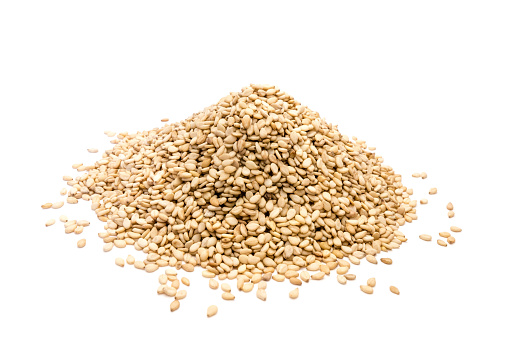HUILE DE SÉSAME
Vers les solutions techniques :
Nous vous conseillons volontiers sur ces graines. Contactez-nous !
Extraction d’huile
L’huile de sésame aromatique est obtenue à partir des graines mûres des graines de sésame par pression à froid ou par pressage à chaud, extraction, raffinage et filtration. Cependant, selon le type de production, une distinction doit être faite entre l’huile de sésame claire et l’huile de sésame foncée: l’huile de graines non torréfiées est appelée huile de sésame claire et l’huile de graines grillées est appelée huile de sésame foncé.
Les graines non pelées des capsules de sésame séchées sont d’abord nettoyées, séchées et enfin, selon le processus de pressage, conditionnées à la vapeur afin de pouvoir mieux séparer l’huile par la suite. Par la suite, les graines peuvent être grillées (uniquement pour l’huile foncée des grains grillés) puis réhydratées à l’aide de vapeur. L’huile peut maintenant en être extraite. Bien que l’extraction présente l’avantage que le rendement en huile est proche de 100%, l’huile pressée mécaniquement a une meilleure qualité. À la fin, l’huile de sésame passe encore par toutes les étapes de filtration d’un moulin à huile. L’huile de sésame est ensuite embouteillée.
Le tourteau de presse, sous-produit de la production d’huile, a une teneur élevée en protéines et est donc souvent utilisé comme aliment pour animaux.
Propriétés et durée de conservation
Les huiles de sésame se distinguent non seulement par leur fabrication, mais aussi par leurs propriétés. Ainsi, l’huile issue de graines de sésame naturelles, lorsqu’elle est pressée à froid, possède une couleur claire, allant du jaune clair au jaune doré, alors que l’huile pressée à chaud est plus foncée. L’huile de sésame raffinée forme un liquide clair, jaune clair et l’huile de sésame obtenue à partir de graines grillées présente une couleur brun foncé.
L’huile de sésame pressée à froid est presque inodore, mais possède une note typique de sésame et une odeur légèrement piquante, grillée et grasse. L’odeur de l’huile de sésame obtenue à partir de graines grillées est en revanche typique, intense et rappelle un peu le pop-corn.
L’huile de sésame claire n’a qu’un léger goût de noix, mais l’huile foncée a un arôme caractéristique, fort, de noix et agréablement grillé.
Pour l’huile de sésame claire, le point de solidification se situe entre -8 et -6°C environ et le point de fumée à 177°C environ ; pour l’huile semi-raffinée, le point de fumée se situe déjà à 230°C environ. Le point de combustion de l’huile de sésame obtenue à partir de graines grillées est d’environ 160°C.
L’huile de sésame se compose d’environ 40% d’acides gras mono-insaturés (surtout de l’acide oléique, oméga 9), d’environ 43% d’acides gras di-insaturés (principalement de l’acide linoléique, oméga 6), d’environ 13,5% d’acides gras saturés (surtout de l’acide palmitique et de l’acide stéarique) et d’environ 2% d’acide α-linolénique tri-insaturé (et oméga 3). Elle contient en outre des substances d’accompagnement telles que, par exemple, des phénols, des phytostérols et des lignanes, et celle pressée à froid et non traitée est particulièrement riche en minéraux, oligo-éléments, lécithine et choline.
La durée de conservation est d’environ 12 mois si l’huile est conservée au frais dans une bouteille non ouverte et à l’abri de la lumière. Les bouteilles entamées ne se conservent que 3 à 6 mois environ.
Utilisation
Dans le domaine pharmaceutique et médical
Dans le domaine pharmaceutique, l’huile de sésame sert de solvant et d’excipient pour les médicaments, principalement pour la production de solutions injectables huileuses et de suspensions injectables de stéroïdes. Elle peut également être utilisée dans la fabrication de pansements et de pommades à la place de l’huile d’olive courante. En outre, la composition lipidique de l’huile de sésame aurait un effet positif sur la coagulation du sang et renforcerait l’activité cardiaque. Elle peut également être utile pour prévenir l’ostéoporose, réduire le taux de cholestérol et consolider les os et les dents. Autre avantage : cette huile peut favoriser la croissance et réduire le risque d’athérosclérose. Enfin, la lignane sésamine a une action immunosuppressive. Elle inhibe donc in vitro la prolifération de lymphocytes du sang périphérique humain induite par la concavaline A.
L’huile de sésame pressée à froid contient une plus grande quantité de lécithine, qui est importante pour le système nerveux, le cerveau, le foie, la bile et les muqueuses et qui peut conduire à une réduction des taux élevés de lipides sanguins et de cholestérol. En outre, les acides gras et les substances associées aux graisses contenues dans l’huile ont la capacité de se lier aux ions de métaux lourds et autres toxines, ce qui permet une élimination efficace par les organes d’élimination. On trouve également dans l’huile de sésame des lignanes, de la sésamoline et de la sésamine. Ces substances végétales secondaires du groupe des lignanes agissent comme de puissants antioxydants, ont des propriétés bactéricides et peuvent également être utilisées en médecine contre les tumeurs. Il semblerait que les sprays nasaux contenant de l’huile de sésame contribuent à soulager environ 80% des patients souffrant de sécheresse des muqueuses nasales, de congestion ou de formation de croûtes.
En médecine populaire
Dans le domaine de la médecine naturelle, l’huile de sésame est appliquée en cas de formes légères de constipation et agit également comme huile de massage et pour détacher les croûtes et les croûtes sur la peau. Selon le “Dictionnaire des graisses et huiles végétales”, l’huile protège en outre la peau des rayons du soleil grâce à un facteur de protection solaire de 2. En Inde, elle est l’une des principales huiles de soin de la peau et est également considérée comme un tonique nerveux. En revanche, elle est souvent utilisée en Asie de l’Est et du Sud-Est en tant qu’onguent contre les rhumatismes et les vertiges.
L’huile de sésame est également très utilisée dans l’ayurveda, une médecine traditionnelle indienne qui compte encore aujourd’hui de nombreux utilisateurs en Inde, au Sri Lanka et au Népal. Elle est utilisée pour les massages à l’huile, les infusions d’huile sur le front et les cures d’extraction d’huile et sert à renforcer le système immunitaire, à soutenir les processus métaboliques dans le corps et à éliminer de la peau les toxines comme les métaux lourds ou les solvants organiques. En outre, cette huile peut être mélangée à des produits d’hygiène buccale qui peuvent, entre autres, éliminer les substances toxiques des muqueuses, renforcer les gencives et réduire les caries et la mauvaise haleine. Des expériences auraient également démontré que l’ingestion d’huile de sésame peut entraîner une baisse de la tension artérielle.
Dans les cosmétiques
L’huile de sésame est également utilisée dans ce domaine. Elle est par exemple utilisée comme bonne huile de soin pour la peau des bébés et est incorporée dans des produits cosmétiques tels que les huiles pour le corps et les huiles de massage, car elle aide à lutter contre la peau sèche et squameuse. D’autres avantages de l’huile de sésame sont qu’elle pénètre rapidement dans la peau et qu’elle favorise la circulation sanguine.
Dans l’industrie
Dans les entreprises industrielles, l’huile de sésame n’est pas seulement utilisée pour fabriquer de la margarine, mais elle est également employée dans l’industrie boulangère. De plus, elle n’a pas tendance à être rancunière et n’a pas de goût ou d’odeur désagréable. Ces avantages sont mis à profit par l’industrie des parfums et des cosmétiques, qui utilise cette huile comme matière première pour de nombreux parfums et huiles parfumées.
Dans l’agriculture
Dans ce domaine, l’huile de sésame est souvent utilisée comme support ou comme composant synergique dans les insecticides. L’avantage est que le pourcentage de pyrèthre contenu dans ces produits peut ainsi être réduit de moitié environ.
Dans la cuisine
Ici aussi, l’huile décrite précédemment est plus souvent utilisée. L’huile plus foncée obtenue à partir des graines grillées est souvent utilisée comme condiment dans la cuisine asiatique en raison de son arôme fort et épicé. Mais en Europe aussi, son arôme de noix peut compléter de manière appropriée les salades, les plats de poisson ou au wok, les soupes, les marinades, les desserts ou même les céréales. L’huile de sésame claire, quant à elle, est plutôt utilisée comme huile de cuisson, de rôtissage, de friture et de grillage, mais aussi pour fumer la viande, le poisson, les légumes ou les produits à base de soja. Au Japon, l’huile de sésame dite orientale, obtenue à partir de graines de sésame décortiquées puis grillées, sert d’huile d’assaisonnement pour la tempura. Elle est également utilisée en petites quantités pour assaisonner certains plats chinois ou coréens.
Le tourteau restant a une teneur élevée en protéines et est donc volontiers utilisé pour la production d’aliments pour animaux.
Outre les connaissances personnelles acquises par des essais de pressage, les sources suivantes ont été utilisées pour la rédaction de cet article :
- Öle, natürlich kaltgepresst, Basiswissen & Rezepte, Marcus Hartmann, Hädecke, 2008
- Heilende Öle, Pflanzenöle als Nahrungs- und Heilmittel, Neue Erkenntnisse, Günter Albert Ulmer Verlag Tuningen
- Lexikon der pflanzlichen Fette und Öle, Krist, Buchbauer, Klausberger, SpringerWienNewYork, 2008
- www.wikipedia.de
- en.wikipedia.org

